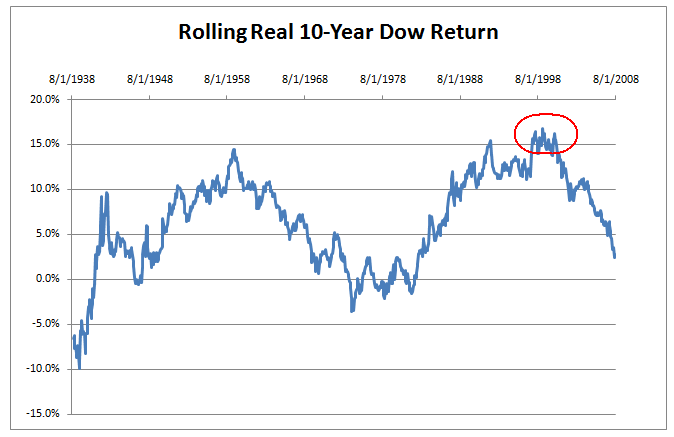Chart of the day: long-term returns
‘Buy and hold’ is a myth that I hope dies an ugly death just like the Efficient Market Hypothesis. When one looks at the numbers, it is as plain as day that the stock market moves in sweeping trends that take decades to unfold.
A long uptrend is followed by a long downtrend. We happen to be in a long downtrend, right now. As far as the Dow is concerned, I have argued for some time that 1998 is actually when this bear began (see my red highlighting on the chart above). In the end, these patterns take so long to unwind that the average investor in a secular bear market is simply beaten down by the preponderance of evidence. Few can resist becoming bearish in the face of the drip-drip of days and weeks of negative feedback. ‘Buy and Hold’ is poison in a secular bear market.
I have had a six-year debate about ‘buy and hold’ with my brother-in-law, who is a very smart guy. My argument is the one I just posited: secular bear markets last so long and returns are so low that the average investor is best served by avoiding ‘buy and hold’ strategies which leave one open to the psychology of the bear and selling at the worst possible time. Basically, even the most independent thinkers eventually are beaten down by the bear and eventually sell, usually after having surrendered significant opportunity costs in alternative investments.
My brother-in-law’s argument is simple but equally compelling: The average investor doesn’t know a rolling ten-year dow return from a hole in the wall. If these investors don’t buy and hold, where are they to go?
Good question. My answer: perhaps they should leave the market altogether and save their money. Many do, but at significant cost once the bear market has already eaten into their returns.
The chart above suggests that we still have a was to go on the downside. If you’re counting on outsized returns in the market, you are going to be disappointed. This is yet another reason that the savings rate is going to go up significantly over the next few years. I would start saving those pennies sooner rather than later. Dan, are you listening?

Ed,
Eventually, exponential growth (compounding) is tethered by real world constraints. That said, I think the history of the long run returns from stocks would be very different absent government support. Consider the creation of the federal reserve, the creation of the income tax, the confiscation and revaluation of gold by FDR, the rise of pension plans during WW2 wage freezes, the end of the Bretton Woods agreement in the 1970s, the RTC, lower tax rates, expanding government spending in relation to gdp, etc.
Absent these artificial supports, I think the long term returns on stocks and bonds would be much closer.
Just thoughts. I certainly could be wrong.
Interesting thoughts. For whatever reason your comments triggered the thought of market-to-market comparisons of returns on equity and bonds. The book ‘Triumph of the Optimist’ does that. Let me see what it says?